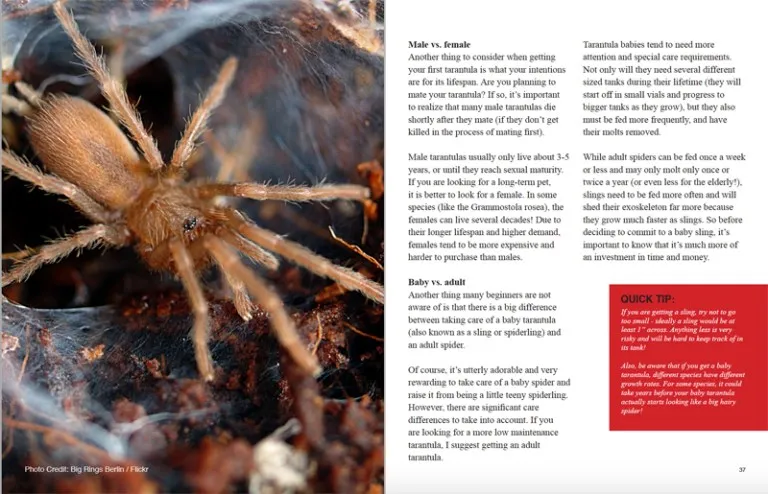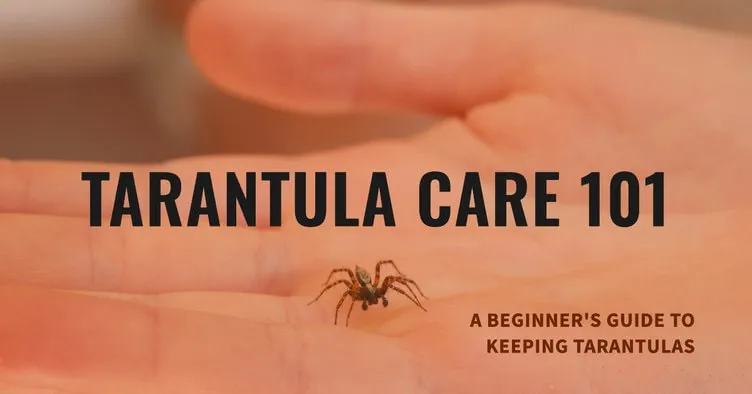Embarking on the journey of tarantula ownership can be an incredibly rewarding experience. These fascinating creatures offer a unique perspective on the animal kingdom, and with the right knowledge, caring for a tarantula can be a relatively easy and enjoyable hobby. This guide is designed specifically for beginners, providing a comprehensive overview of everything you need to know to successfully care for your first tarantula. From selecting the right species to understanding their needs, this guide is your starting point for becoming a responsible and knowledgeable tarantula owner.
Choosing Your First Tarantula
The first and arguably most important step is choosing the right tarantula. Not all species are created equal when it comes to ease of care and temperament. Some tarantulas are more docile and better suited for beginners, while others may be more defensive or require specific environmental conditions. Researching different species thoroughly will help you make an informed decision and set you up for success. Considering the tarantula’s size when fully grown, lifespan, and feeding requirements can help to ensure your pet thrives.
Researching Tarantula Species
Before purchasing a tarantula, dedicate time to research. Learn about the species’ native habitat, preferred temperature and humidity levels, and dietary needs. Websites, books, and forums dedicated to tarantulas offer valuable insights and real-world experiences from other keepers. Look for information on the species’ temperament; some tarantulas are more prone to biting or kicking urticating hairs (tiny hairs that can cause irritation). Understanding these aspects ensures you can provide the best possible care.
Popular Beginner Tarantula Species

Several tarantula species are recommended for beginners due to their docile nature, hardiness, and relatively low maintenance requirements. The Chilean Rose Hair (Grammostola rosea), the Pinktoe Tarantula (Avicularia avicularia), and the Curly Hair Tarantula (Tliltocatl albopilosus) are popular choices. These species tend to be less defensive and can tolerate a wider range of environmental conditions, making them ideal for those new to tarantula keeping. Remember that individual tarantula personalities can vary, so handle them with caution and always respect their space.
Creating the Perfect Tarantula Habitat
Creating a suitable habitat is essential for your tarantula’s well-being. This involves selecting the right enclosure, choosing appropriate substrate, and maintaining the correct temperature and humidity levels. The habitat should mimic the tarantula’s natural environment as closely as possible, providing a comfortable and secure space for your pet to thrive. This careful setup reduces stress on the animal and promotes its health and longevity.
Choosing the Right Enclosure
The enclosure size depends on the tarantula’s species and size. A general rule is to provide an enclosure that is at least twice as wide as the tarantula’s leg span. Glass or acrylic tanks with secure lids are suitable. Make sure the enclosure provides adequate ventilation to prevent the buildup of mold and bacteria, but avoid areas where the tarantula could escape. Consider the tarantula’s natural behavior, terrestrial species prefer ground space, while arboreal species require climbing structures.
Substrate Selection

The substrate serves as the tarantula’s floor, providing a place to burrow, hide, and feel secure. Suitable substrate options include coconut fiber, peat moss, or a mix of both. These materials retain moisture well, helping to maintain the appropriate humidity levels. Avoid using substrates that contain pesticides or fertilizers. The depth of the substrate depends on the species; burrowing species will need a deeper layer to create their burrows.
Temperature and Humidity Control
Tarantulas are ectothermic (cold-blooded), meaning they rely on their environment to regulate their body temperature. Maintaining the correct temperature and humidity is vital for their health. Most species thrive in temperatures between 75-85°F (24-29°C). Humidity levels vary depending on the species, ranging from 60% to 80%. Use a hygrometer to monitor humidity and mist the enclosure with water as needed. Provide a water dish with fresh water at all times.
Setting up the Habitat
Once you have selected the enclosure, substrate, and humidity and temperature devices, it is time to set up the habitat. Add the substrate to the enclosure to the correct depth, and then add any decorations. These could include a hide, such as a piece of cork bark or a plastic shelter, and some plants. Ensure the decorations are securely placed to prevent them from falling and potentially harming your tarantula. Finally, place the water dish and position the enclosure away from direct sunlight or drafts.
Feeding Your Tarantula

Feeding your tarantula correctly is crucial for its health and longevity. Providing the appropriate food, feeding frequency, and portion sizes can significantly impact the tarantula’s well-being. Overfeeding can lead to health problems, while underfeeding can cause stress and malnutrition. Research the specific dietary needs of your tarantula species to ensure you are meeting its nutritional requirements.
What Tarantulas Eat
Tarantulas are primarily insectivores. Their diet typically consists of insects like crickets, mealworms, roaches, and superworms. The size of the prey should be appropriate for the size of your tarantula; as a general rule, the prey should be no larger than the tarantula’s body. Variety is essential for good nutrition. Supplementing the diet with pre-killed insects or offering a small amount of vitamin-enriched food can provide added nutritional benefits.
Feeding Frequency and Portion Size
The feeding frequency depends on the tarantula’s age and size. Spiderlings and juveniles require more frequent feeding (2-3 times per week). Adult tarantulas can be fed less frequently (once a week or every other week). Observe your tarantula’s eating habits. If it consistently refuses food, it may be nearing a molt, or the environmental conditions may not be ideal. Remove uneaten prey within 24 hours to prevent stress and potential injury to the tarantula.
Watering Your Tarantula

Fresh water is essential for all tarantulas. Provide a shallow water dish with fresh, clean water at all times. The water dish should be shallow enough to prevent the tarantula from drowning. For smaller tarantulas, you can use a cotton ball soaked in water as a source of hydration. Regularly check and refill the water dish, ensuring the water is always clean and available, especially during molting.
Handling Your Tarantula Safely
Handling a tarantula is not always necessary and is often best avoided, especially for beginners. However, if you choose to handle your tarantula, it’s essential to do so safely to protect both yourself and the spider. Handling should only be done with a calm and docile species and only when necessary, such as for health checks or enclosure cleaning. Respecting the spider’s personal space and understanding its behavior are vital for a positive experience.
When to Handle
Handling should be minimized to reduce stress on the tarantula. Only handle the tarantula when necessary, such as for health checks, enclosure cleaning, or if it escapes. Avoid handling during or shortly after molting, as their exoskeletons are soft and vulnerable during this time. It’s best to let the tarantula acclimate to its environment before attempting to handle it. Some tarantulas may never become comfortable with handling, and it’s important to respect their individual temperaments.
Safe Handling Techniques

If you choose to handle your tarantula, approach it calmly and slowly. Avoid sudden movements or loud noises, as these can startle the tarantula. Gently coax the tarantula onto your hand, allowing it to walk on its own. Never grab or force the tarantula. Handle the tarantula close to the ground to prevent falls. Be aware of its potential defenses; some tarantulas kick hairs that cause irritation. Wash your hands thoroughly after handling.
Identifying and Addressing Health Issues
Just like any pet, tarantulas can experience health problems. Recognizing these issues early is crucial for providing proper care and treatment. Regular observation of your tarantula’s behavior, appetite, and physical condition is vital for detecting any signs of illness or distress. Prompt action can prevent minor issues from escalating into more serious problems, ensuring the well-being of your pet.
Common Tarantula Health Problems
Some common health problems in tarantulas include dehydration, parasitic mites, and fungal infections. Dehydration can be caused by insufficient water or low humidity levels. Parasitic mites are tiny pests that can infest the tarantula’s body and cause irritation. Fungal infections can occur if the enclosure is too humid or if the substrate is not properly maintained. Preventing these issues involves maintaining optimal environmental conditions, providing a clean habitat, and ensuring the tarantula has access to fresh water.
Recognizing Signs of Illness

Watch for signs that might indicate your tarantula is sick. Loss of appetite, lethargy, changes in behavior (such as hiding more than usual), and unusual body postures could indicate a problem. Check for any visible signs of mites or fungal growth. If you notice any unusual symptoms, consult with a veterinarian experienced in exotic animals or a knowledgeable tarantula keeper for advice. Early intervention can often lead to a successful recovery.
Molting Process Explained
Molting is a natural and essential process for tarantulas, allowing them to grow and replace their exoskeleton. Understanding the molting process is important for tarantula owners, as it can sometimes seem concerning to beginners. During molting, the tarantula sheds its outer layer, revealing a new, larger one underneath. Recognizing the signs of an impending molt and knowing how to support your tarantula during this vulnerable time are key aspects of responsible care.
Preparing for Molting
As a tarantula approaches a molt, it may stop eating and become less active. You may notice its abdomen becoming darker. The tarantula might also spend more time in its hide or burrow. It’s important to maintain the correct temperature and humidity levels and provide a shallow dish of water. Do not disturb the tarantula during this time. Keep the enclosure clean and free from stress.
What to Do During and After Molting
During the molt, the tarantula will typically flip onto its back and shed its exoskeleton. This can take several hours or even days, and it’s crucial not to disturb the tarantula. After molting, the tarantula will be very vulnerable. Do not feed it for several days to allow its new exoskeleton to harden. Provide fresh water. Avoid handling the tarantula until its fangs have hardened, as it could be easily injured.
Essential Tarantula Care Tips
Caring for a tarantula can be a rewarding experience, but it requires commitment and responsibility. By following the tips outlined in this guide, you can provide your tarantula with a healthy and fulfilling life. Remember to research the specific needs of your species, observe your tarantula’s behavior, and always prioritize its well-being. With patience and diligence, you can enjoy the fascinating world of tarantula keeping and become a successful pet owner.
Keeping tarantulas can be an enjoyable and fulfilling hobby. Always research the species you’re planning to own and be prepared to provide a safe and secure environment. By following this beginner’s guide, you will be well-equipped to provide excellent care for your pet tarantula and enjoy the unique experience of owning one of these amazing creatures.
